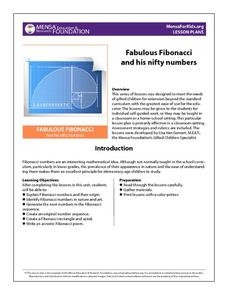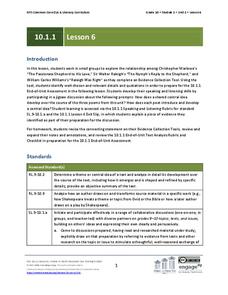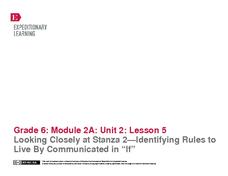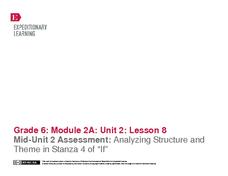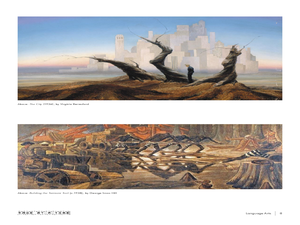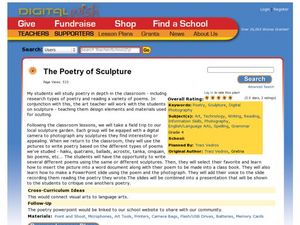Curated OER
"Thank You Ma'am" by Langston Hughes
Students use Langston Hughes' "Thank You Ma'am" as a reading and vocabulary improvement activity. In this reading and vocabulary lesson, students review the related vocabulary and read the poem. Students discuss the story elements in the...
Curated OER
Using Imagery in Poetry
Students examine the use of imagery in poetry. In this literature lesson, students read "Thought of Hanoi," by Nguyen Thi Vinhand use the provided graphic organizer to chart the poem imagery. Students then describe the imagery found in...
Curated OER
Analyzing Sonnets
Model for your class how to craft an analysis of a sonnet by examining the literary techniques used, the background of the poet, and critical reviews of the poem. As guided practice, learners are assigned a sonnet, complete a preliminary...
Curated OER
Creative Writing and Analysis
Students read and analyze poems by Li Po and Wang Wei. They answer discussion questions, identify the elements of the poems, examine and discuss Chinese landscape paintings, write an original poem, and write a comparison/contrast essay.
Maryland Department of Education
A Raisin in the Sun and Dreams Deferred
To conclude a study of A Raisin in the Sun and to prepare for a visit to the Lewis Museum, class members analyze Langston Hughes' poem "Harlem." Learners then draw connections to characters in the play and to their own experiences...
California Department of Education
Call the Tune: Music in Literature
I am dancing to the music in my head. Scholars learn to listen for music in their heads as they read literature and poems. After they identify and analyze poetic devices that relate to music, they create their own musical poems.
EngageNY
Grade 10 ELA Module 1: Unit 1, Lesson 7
Can three works of literature work together to establish and develop a common central idea? Put your thoughts into writing with a final assessment focused on a unit-long analysis of Christopher Marlowe's "The Passionate Shepard to His...
MENSA Education & Research Foundation
Fabulous Fibonacci and His Nifty Numbers
Fibonacci numbers are not only found in the classroom but also in nature. Explore the concept of Fibonacci numbers through a series of lessons designed to gain insight into the mathematical reasoning behind the number pattern, and spark...
EngageNY
Grade 10 ELA Module 1: Unit 1, Lesson 6
Wrap up your literary analysis unit with a discussion activity as tenth graders prepare for an end-of-unit assessment. After they have read and annotated Christopher Marlowe's "The Passionate Shepard to His Love," Sir Walter Raleigh's...
EngageNY
Grade 9 ELA Module 2: Unit 1, Lesson 13
Whether the planks hide the beating of a hideous heart or they break away to the madness beneath, their presence makes itself known in the final instructional activity of a literary analysis unit. Having gathered textual evidence from...
Roy Rosenzweig Center for History and New Media
The Revolutionary Times as Seen Through the Eyes of Women
The role of women before and during the American Revolution changed dramatically. To gain an understanding of these changes, middle schoolers analyze primary source documents, including letters from women that supported the patriot cause...
Curated OER
My Antonia: Biopoem Writing Strategy
Explore the characters in My Antonia by Willa Cather with a biopoem assignment. Pupils use the provided format to write their poems about any character from the book.
EngageNY
Notices and Wonders of the Second Stanza of “If”
Here is an instructional activity that asks pupils to analyze poetry and sparks discussion about two different types of texts: asking how is the poem, If by Rudyard Kipling alike and different from the story, Bud, Not Buddy by...
EngageNY
Looking Closely at Stanza 2—Identifying Rules to Live By Communicated in “If”
Pupils take part in a close reading of the poem, If by Rudyard Kipling, in which they delve deep into its meaning and identify its rules to live by. As the grand discussion progresses, learners then relate the poem's rules with those...
EngageNY
Grade 11 ELA Module 2: Unit 2, Lesson 11
In Audre Lorde's poem "From the House of Yemanjá," the speaker describes her mother's two faces, adding a whole new meaning to the phrase "two-faced." Pupils first read the final stanza of the contemporary poem. With a Quick Write, they...
Curated OER
Ballad
Young balladeers analyze examples of ballads and generate a list of common traits (story, quatrains, rhyme schemes, refrains, etc.), then identify these traits in Robert W. Service's "The Cremation of Sam McGee" and a ballad written by...
EngageNY
Analyzing Structure and Theme in Stanza 4 of “If”
Here is a lesson plan that provides scholars with two opportunities to stretch their compare-and-contrast muscles. First, learners compare and contrast their experience reading the fourth stanza of If by Rudyard Kipling to listening to...
EngageNY
Grade 11 ELA Module 2: Unit 2, Lesson 12
Why is it important to make connections across texts? Scholars discover the answer with instructional activity 12 of 14 from the Grade 11 ELA Module 2: Unit 2 series. Pupils analyze the development of ideas in three nonfiction texts,...
EngageNY
Grade 11 ELA Module 2: Unit 2, Lesson 13
Two minds are better than one. Learners engage in an evidence-based discussion to identify central ideas in Audre Lorde's poem "From the House of Yamanjá" and one additional nonfiction text. They complete a Cross-Evidence Collection Tool...
K20 LEARN
The New Colossus: Determining Author's Perspective
Introduce young scholars to the concept of the author's perspective with a lesson that uses Emma Lazarus's poem, "The New Colossus," as the anchor text. Groups use a T-chart to identify words that reveal the author's point of view...
Curated OER
Art Analysis and Creative Writing
Students write an acrostic poem and analyze a work of art. In this art lesson plan, students look at a picture and answer questions about it, write a poem, write about the setting in the painting they saw, and answer short questions...
Curated OER
He Sees it in His Joy
Students research the importance of play. In this research lesson, students work in pairs and interview each other about their 'play history.' Students take data from the interview and shape it into a play history for the individual....
Curated OER
The Poetry of Sculpture
Fourth graders practice writing poetry while examining all types of art. In this art analysis lesson, 4th graders participate in a field trip to a sculpture garden in which they view sculptures and create different forms of poetry...
Curated OER
Spider Poems: The Spider and the Fly
Students review the information they gathered on different websites to write a poem about spiders. They use other websites to gain more information if needed. They share their poem with the class.
Other popular searches
- Elements of Poetry Analysis
- Poetry Analysis Worksheets
- Literary Analysis for Poetry
- Pablo Neruda Poetry Analysis
- Poetry Analysis Rubric
- Tpcastt Poetry Analysis
- Poetry Analysis Document
- Spanish Poetry Analysis
- Reading and Analyzing Poetry
- Poe Poetry Analysis
- Typecast Poetry Analysis
- Analyzing Poetry Structure







